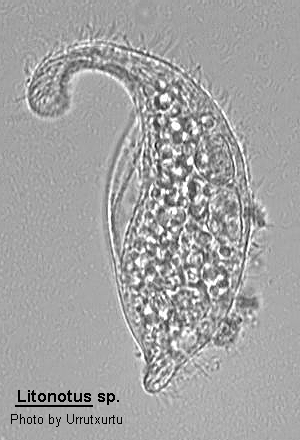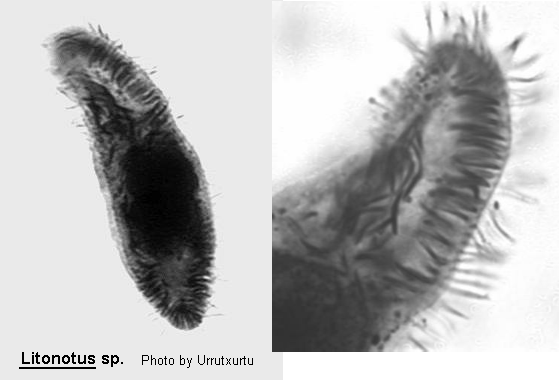Litonotus
Litonotus Wrzesniowski, 1870 (ref. ID; 2013) or Lionotus Wrzesniowski, 1870 (ref. ID; 3690)

Body laterally compressed, highly elongate with anterior neck-like region which bends towards the dorsal edge. Oral aperture a slit, on convex edge of neck extending less than halfway down the body. Ciliation present on both lateral surfaces. Ciliation on right surface takes the form of parallel longitudinal rows which do not converge on each other. There are some longer cilia on the neck region forming a mane-like structure. Trichocysts sometimes present. Macronucleus commonly in two spherical parts with single micronucleus wedged between the two. One to several contractile vacuoles present.
Quote; Colin R. Curds "British and other freshwater ciliated protozoa Part I Ciliophora: Kinetofragminophora" Cambridge University Press, 1982 (ref. ID; 2013)
- Litonotus alpestris Foissner, 1978 (ref. ID; 4612) reported year? (ref. ID; 3698) reported author and year? (ref. ID; 1629)
- Litonotus binucleatus Kahl, 1933 (ref. ID; 3119)
- Litonotus bonnensis (ref. ID; 4612)
- Litonotus crystallinus (Vuxanovici, 1960) (ref. ID; 4612) reported author and year? (ref. ID; 1629)
- Litonotus cygnus (O.F. Muller, 1773) (ref. ID; 4612) or 1776(?) (ref. ID; 3119) reported year? (ref. ID; 3698) or (O.F. Muller, 1776) Wrzesniowski, 1870 (ref. ID; 1219, 1622, 1629, 2117)
Syn; Gastrotricha folium Wrzesniowski, 1866 (ref. ID; 4612); Lionotus anas Levander, 1894 (ref. ID; 1622); Lionotus anser Butschli, 1889 (ref. ID; 3115); Lionotus filum Gruber (ref. ID; 1622); Lionotus folium Wrzesniowski, 1870 (ref. ID; 3115); Litonotus wrzesniowskii Kent, 1882 (ref. ID; 4612); Vibrio cygnus O.F. Muller, 1773 (ref. ID; 4612) or 1776 (ref. ID; 1622) - Litonotus elongatus Dragesco (ref. ID; 2117)
- Litonotus fasciola (Ehrenberg) (ref. ID; 1219, 1618, 2245, 3698) or (Ehrenberg) Wrzesniowski, 1870 (ref. ID; 3115)
Syn; Amphileptus fasciola Ehrenberg, 1838 (ref. ID; 3115); Dileptus fasciola Fromentel, 1874 (ref. ID; 3115); Loxophyllum fasciola Claparede & Lachmann, 1981 (ref. ID; 3115); Vibrio fasciola O.F. Muller 1786 (ref. ID; 3115) - Litonotus fasciola (O.F. Muller) Wrzesniowski 1870 (ref. ID; 2316) reported year? (ref. ID; 1335)
- Litonotus fusidens (Kahl, 1926) Foissner et al., 1995 (ref. ID; 4488, 4612) reported author and year? (ref. ID; 1629, 1896)
Syn; Lionotus fusidens Kahl, 1926 (ref. ID; 4612) - Litonotus helus Stokes, 1884
See; Loxophyllum helus (ref. ID; 1622, 4612) - Litonotus lamella (ref. ID; 7255)
- Litonotus lamella (Ehrenberg) Schewiakoff, 1896 (ref. ID; 3115) reported year? (ref. ID; 1219, 1629, 1896, 2245) or Schewiakoff (ref. ID; 3698)
Syn; Loxophyllum lamella Claparede & Lachmann, 1861 (ref. ID; 3115); Trachelius lamella Ehrenberg, 1829 (ref. ID; 3115) - Litonotus lamella Fryd-Versavel et al., 1975
See; Acineria incurvata (ref. ID; 1601) - Litonotus lamella (O.F. Muller, 1773) (ref. ID; 4612)
Syn; Kolpoda lamella O.F. Muller, 1773 (ref. ID; 4612); Trachelius lamella (O.F. Muller, 1773) Ehrenberg, 1838 (ref. ID; 4612) - Litonotus lamella var. armatum (ref. ID; 4612)
- Litonotus lamella var. uninucleolata Schewiakoff, 1896 (ref. ID; 645)
- Litonotus mononucleatus (ref. ID; 4612)
- Litonotus muscorum (Kahl, 1931) Blatterer & Foissner, 1988 (ref. ID; 4861)
- Litonotus pygmaeus (ref. ID; 4612)
- Litonotus uninucleatus Foissner (ref. ID; 3698) reported author and year? (ref. ID; 4612)
- Litonotus varsaviensis (Wrzesniowski, 1866) Wrzesniowski, 1870 (ref. ID; 4612) reported author and year? (ref. ID; 1629)
Syn; Gastrotricha varsaviensis Wrzesniowski, 1866 (ref. ID; 4612) - Litonotus vermicularis Stokes, 1887
See; Homalozoon vermiculare (ref. ID; 4612) - Litonotus verrucosum Florentin, 1889
See; Loxophyllum helus - Litonotus wrzesniowskii Kent, 1882
See; Litonotus cygnus (ref. ID; 4612)
- Lionotus anaticula Claparede & Lachmann, 1858 (ref. ID; 1622)
- Lionotus anguilla Kahl (ref. ID; 3690) reported author and year? (ref. ID; 1622)
- Lionotus armillatus Penard, 1922 (ref. ID; 1622)
- Lionotus avellens (ref. ID; 3292)
- Lionotus carinatus Stokes, 1885 (ref. ID; 1622) reported year? (ref. ID; 3342)
- Lionotus crinitus R. & L. Grandoei, 1934 (ref. ID; 1620)
- Lionotus crystallinus Vuxanovici, 1960 (ref. ID; 4612)
- Lionotus cygnus (O.F. Muller), 1776 (ref. ID; 1622, 4612)
- Lionotus digitatus R. & L. Grandoei, 1934 (ref. ID; 1620)
- Lionotus duplostriatus (Maupas, 1883) (ref. ID; 1622)
- Lionotus dusarti Dragesco, 1960 (ref. ID; 3690 original paper)
- Lionotus elongatus Dragesco (ref. ID; 3690)
- Lionotus fasciola Ehrenberg-Wrzeseniowski, 1870 (ref. ID; 1622)
- Lionotus fusidens Kahl, 1926 (ref. ID; 4612)
- Lionotus hirundo Penard, 1922 (ref. ID; 1622)
- Lionotus indica Gulati, 1926 (ref. ID; 1622)
- Lionotus infusionus Ghosh, 1920 (ref. ID; 1622)
- Lionotus lamella (Ehrenberg, 1829) (ref. ID; 3593) reported year? (ref. ID; 5624) or (Ehrenberg) Schewiakoff, 1896 (ref. ID; 1622, 2117) reported year (ref. ID; 3342, 3690)
- Lionotus lamella var. rotundus Kahl, 1926
See; Hemiophrys rotunda (ref. ID; 1622) - Lionotus lamellus Ehrenberg (ref. ID; 3544)
- Lionotus muscorum (ref. ID; 1622)
- Lionotus obtusus Maupas, 1888 (ref. ID; 1622)
- Lionotus pictus Gruber, 1884 (ref. ID; 1620, 1622)
- Lionotus pictus var. binucleatrus Kahl, 1933 (ref. ID; 1620)
- Lionotus piger Vuxanovici, 1962
See; Amphileptus punctatus (ref. ID; 4612) - Lionotus pleurosigma Stokes, 1884
See; Amphileptus pleurosigma (ref. ID; 4612), Hemiophrys pleurosigma (Stokes, 1884) Kahl, 1931 - Lionotus procerus Penard, 1922
See; Amphileptus procerus (ref. ID; 4612) - Lionotus punctatus Kahl, 1926
See; Amphileptus punctatus (ref. ID; 4612), Description of Amphileptus parafusidens (ref. ID; 4942) - Lionotus reversus Kahl, 1926
See; Acineria incurvata Dujardin, 1841 (ref. ID; 1601) - Lionotus trichocystus Stokes, 1885 (ref. ID; 1622)
- Lionotus triqueter Penard, 1922 (ref. ID; 1622)
- Lionotus varsaviensis Wrzesniowski, 1870 (ref. ID; 1622, 4488)
- Lionotus vesiculosus Stokes, 1885 (ref. ID; 1622)
Litonotus fasciola (Ehrenberg) (ref. ID; 1219, 1618, 2245, 3698) or (Ehrenberg) Wrzesniowski, 1870 (ref. ID; 3115)
Synonym
Amphileptus fasciola Ehrenberg, 1838 (ref. ID; 3115); Dileptus fasciola Fromentel, 1874 (ref. ID; 3115); Loxophyllum fasciola Claparede & Lachmann, 1981 (ref. ID; 3115); Vibrio fasciola O.F. Muller 1786 (ref. ID; 3115)Descriptions
Body elongated; right side flat, left side more or less convex; anterior and posterior parts flattened and hyaline; mouth a long slit, about one-third to one-half the total length of body. (ref. ID; 1219)Elongate flask in form; hyaline; with flattened neck and tail, both of which are moderately contractile; posterior end bluntly rounded; without trichocysts; neck stout, bent toward the dorsal side; cytostome a long slit; contractile vacuole posterior; two spherical macronuclei between which a micronucleus is located; fresh water and probably also in salt water. (ref. ID; 1618)